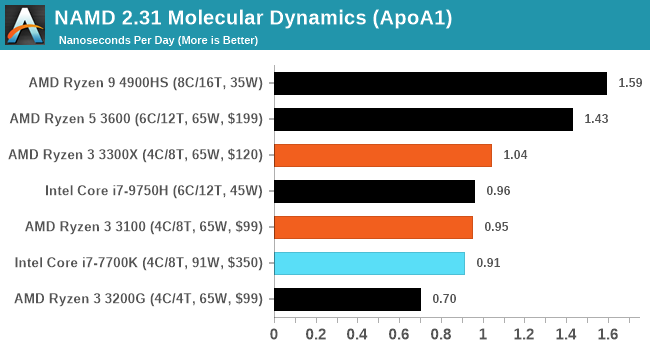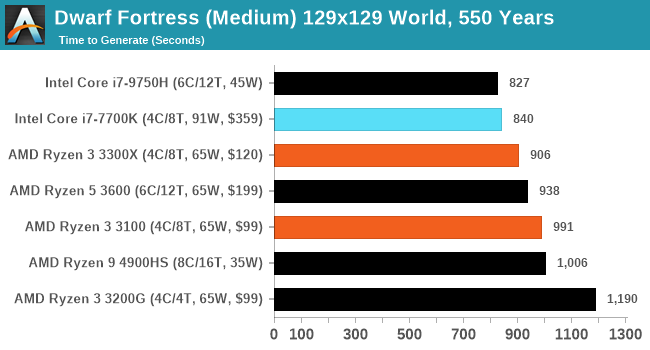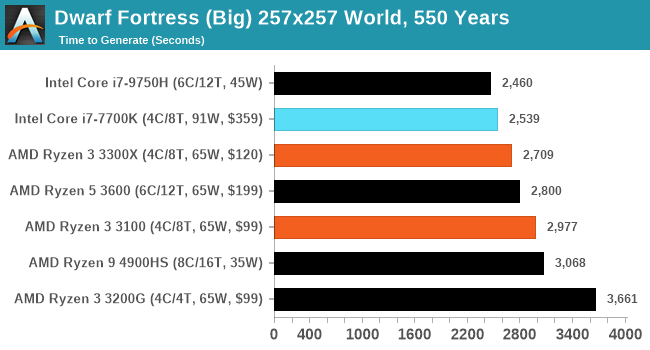The AMD Ryzen 3 3300X and 3100 CPU Review: A Budget Gaming Bonanza
by Dr. Ian Cutress on May 7, 2020 9:00 AM ESTCPU Performance: New Tests!
As part of our ever on-going march towards a better rounded view of the performance of these processors, we have a few new tests for you that we’ve been cooking in the lab. Some of these new benchmarks provide obvious talking points, others are just a bit of fun. Most of them are so new we’ve only run them on a few processors so far. It will be interesting to hear your feedback!
NAMD ApoA1
One frequent request over the years has been for some form of molecular dynamics simulation. Molecular dynamics forms the basis of a lot of computational biology and chemistry when modeling specific molecules, enabling researchers to find low energy configurations or potential active binding sites, especially when looking at larger proteins. We’re using the NAMD software here, or Nanoscale Molecular Dynamics, often cited for its parallel efficiency. Unfortunately the version we’re using is limited to 64 threads on Windows, but we can still use it to analyze our processors. We’re simulating the ApoA1 protein for 10 minutes, and reporting back the ‘nanoseconds per day’ that our processor can simulate. Molecular dynamics is so complex that yes, you can spend a day simply calculating a nanosecond of molecular movement.

Crysis CPU Render
One of the most oft used memes in computer gaming is ‘Can It Run Crysis?’. The original 2007 game, built in the Crytek engine by Crytek, was heralded as a computationally complex title for the hardware at the time and several years after, suggesting that a user needed graphics hardware from the future in order to run it. Fast forward over a decade, and the game runs fairly easily on modern GPUs, but we can also apply the same concept to pure CPU rendering – can the CPU render Crysis? Since 64 core processors entered the market, one can dream. We built a benchmark to see whether the hardware can.
Smooth#canitruncrysis pic.twitter.com/k7x31ULndF
— 𝐷𝑟. 𝐼𝑎𝑛 𝐶𝑢𝑡𝑟𝑒𝑠𝑠 (@IanCutress) May 4, 2020
For this test, we’re running Crysis’ own GPU benchmark, but in CPU render mode. This is a 2000 frame test, which we run over a series of resolutions from 800x600 up to 1920x1080.
| Crysis CPU Render Frames Per Second |
||||||
| AnandTech | 800 x600 |
1024 x768 |
1280 x800 |
1366 x768 |
1600 x900 |
1920 x1080 |
| AMD | ||||||
| Ryzen 9 4900HS | 11.50 | 8.75 | 7.44 | 6.83 | 5.21 | 4.30 |
| Ryzen 5 3600 | 9.98 | 7.84 | 6.69 | 6.15 | 4.75 | 3.92 |
| Ryzen 3 3300X | 8.42 | 6.52 | 5.43 | 5.01 | 3.92 | 3.07 |
| Ryzen 3 3100 | 7.50 | 5.78 | 4.87 | 4.5 | 3.54 | 2.77 |
| Intel | ||||||
| Core i7-7700K | 7.63 | 5.87 | 4.95 | 4.55 | 3.57 | 2.79 |
| Core i7-9750H | 6.78 | 5.17 | 4.37 | 3.99 | 3.12 | 2.46 |
Dwarf Fortress
Another long standing request for our benchmark suite has been Dwarf Fortress, a popular management/roguelike indie video game, first launched in 2006. Emulating the ASCII interfaces of old, this title is a rather complex beast, which can generate environments subject to millennia of rule, famous faces, peasants, and key historical figures and events. The further you get into the game, depending on the size of the world, the slower it becomes.
DFMark is a benchmark built by vorsgren on the Bay12Forums that gives two different modes built on DFHack: world generation and embark. These tests can be configured, but range anywhere from 3 minutes to several hours. I’ve barely scratched the surface here, but after analyzing the test, we ended up going for three different world generation sizes.



Interestingly Intel's hardware likes Dwarf Fortress.
We also have other benchmarks in the wings, such as AI Benchmark (ETH), LINPACK, and V-Ray, however they still require a bit of tweaking to get working it seems.










249 Comments
View All Comments
PeterCollier - Thursday, May 7, 2020 - link
Ugh, how much did Intel pay you for this article?kulareddy - Thursday, May 7, 2020 - link
How much did AMD pay you for this comment?callmebob - Thursday, May 7, 2020 - link
They paid him with old new stock of a dozen 1st gen Bulldozer CPUs.Just having the AMD logo on them will make him blissfully happy. No need to waste good products on him ;-)
kulareddy - Thursday, May 7, 2020 - link
👏👏👏PeterCollier - Saturday, May 9, 2020 - link
This makes no sense.Teckk - Thursday, May 7, 2020 - link
I genuinely want to understand why you think so?You really believe this article puts Intel's chips in a good light?
Would've preferred to see a set of different/recent processors in comparison but your comment is confusing lol.
Teckk - Thursday, May 7, 2020 - link
Arghhh .. meant as a reply to @PeterCollierkulareddy - Thursday, May 7, 2020 - link
👍PeterCollier - Friday, May 8, 2020 - link
Yestwtech - Friday, May 8, 2020 - link
I guess one point might be that in most of the comparisons, there are no higher-end AMD CPUs included. So you see that Intel's higher-end processors are better for gaming, but not that there are AMD options as well further up the chain.Even so, I think Intel holds the gaming FPS crown anyway for the moment, with their new 10900k (which isn't on this chart). That 5.3 boost clock should be pretty good for achieving maximal framerates.
Other than losing to Intel at max-FPS gaming though, AMD dominates all segments from a price/performance, raw performance, and power efficiency performance. Server, mobile, workstation, gaming, etc.